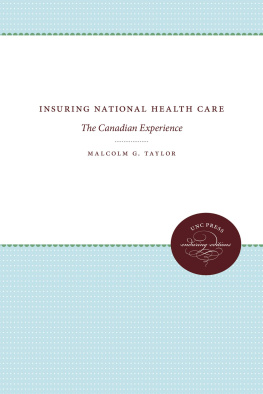Insuring National Health Care
1990 The University of North Carolina Press
All rights reserved
Library of Congress Cataloging-in-Publication Data
Taylor, Malcolm G. (Malcolm Gordon)
Insuring national health care : the Canadian experience / by Malcolm G. Taylor.
p. cm.
Includes bibliographical references.
ISBN 0-8078-1934-4 (alk. paper).ISBN 0-8078-4295-8 (alk. paper : pbk.)
1. Insurance, HealthCanadaHistory. 2. Insurance, HealthGovernment policyCanada. I. Title.
HD7102.C2T34 1990
368.4200971dc20 90-50014 CIP
This book is an abridgment and revision of Malcolm G. Taylors Health Insurance and Canadian Public Policy: The Seven Decisions That Created the Canadian Health Insurance System 1978 The Institute of Public Administration of Canada/LInstitut dadministration publique du Canada (Canadian public administration series/Collection Administration publique canadienne), copublished with McGill-Queens University Press; and Health Insurance and Canadian Public Policy: The Seven Decisions That Created the Canadian Health Insurance System and Their Outcomes (2d ed.), 1987 The Institute of Public Administration of Canada/LInstitut dadministration publique du Canada (Canadian public administration series/Collection Administration publique canadienne), copublished with McGill-Queens University Press.
Design by Julianne Mertz Whitling
The paper in this book meets the guidelines for permanence and durability of the Committee on Production Guidelines for Book Longevity of the Council on Library Resources.
Manufactured in the United States of America
94 93 92 91 90 5 4 3 2 1
THIS BOOK WAS DIGITALLY MANUFACTURED .
For Helen, Deanne, Diana, and Burke
Contents
Tables
Federal and Provincial Expenditures on Hospital and Medical Services, 197677 to 198889 /
Basis of Federal Contributions for Health Insurance /
Estimated Enrollment in Voluntary Commercial Insurance and Prepayment Plans, 195052 /
Government Expenditures for Hospital and Medical Insurance Programs, Selected Fiscal Years, 197677 to 198889 / 57
Total Canada Health Expenditures, 1975, 1981, and 1987 / 91
Projected Canadian Population to 2021 and Proportion of the Population Aged 65 or Over /
Projected Percentage Increases in Health Services Use, 1981 to 2021 /
Projected Percentage Increases in Health Service Demand because of Demographic Change /
Projected Operating and Construction Cost Increases by 2021 /
Financial Savings of Three Scenarios /
Financial Savings from Status Quo Projections of Annual Operating Costs in the Year 2021 /
Physician Supply, Requirements, and Surplus (Shortage), 1980 and 2000 /
Three Health Systems: Comparative Facts /
Three Nations Rate Their Own Health System /
Preference for an Alternative System /
Preface
There are four essential criteria on which to evaluate a health services system: the quality and availability of its health care facilities and professional services; the comprehensiveness of the range of insured benefits; the equity of its system of financing, including taxes or premiums and the amounts of deductibles and coinsurance; and, not least, the proportion of the gross national product (GNP) that a comprehensive health services system requires to be allocated to it. Canadas health services system may be excelled by other countries on any one of these criteria, but taking all four together, Canadas system ranks at or near the top.
Such, at least, was the conclusion of Spyros Andreopoulos, editor of the proceedings of the Sun Valley Forum on National Health, which met in Sun Valley, Idaho, in the summer of 1974 to focus on the Canadian health services and insurance system. In Chapter 10 below, I also conclude that Canada has much to learn from the United States, particularly in improving its forms of health services delivery.
Since Canada is a federal system, with most health matters falling within the jurisdiction of the constituent provinces, and since professional interest groups exert strong political influence, it was not to be expected that the ultimate objective of a nationwide system would be achieved without extraordinary political battles. And so there were, with warfare along three fronts: among the political parties, between the federal government and the provincial governments, and between the provincial governments and their respective medical associations.
This book is the chronicle of that stormy evolution of the Canadian health insurance system over a half-century. In 1919when there was also a good deal of interest in health insurance in the United Statesthe newly elected leader of the national Liberal party, Mackenzie King, had persuaded the delegates to the leadership convention to commit the party to a national health insurance program. It was not until 1940, however, that the federal government began to study the issue in earnest. That exercise culminated in the 1945 offer by the federal government to contribute to a comprehensive range of health services to be administered by the provinces. Because of the financial conditions attached by the federal government, the offer was rejected by several of the larger provinces. It would take another eleven years for the federal government to make (most reluctantly, as we shall see) its second, and more limited, offer of the first stagenational hospital care insurancewhich took until 1960 to be accepted by all the provinces. In 1965 the second stageMedicarewas offered, and by 1971 that program was in effect nationwide. (I am aware of the possible confusion of American readers over the use of this term by Canadians, since it refers to two quite different kinds of programs in the two countries. Throughout, my reference to Medicare is to the Canadian program, which covers the entire population and refers only to medical services.)
As a consequence, all residents of Canada are now entitled to a full range of medical and hospital services without deductibles or coinsurance, supplemented in most provinces by nursing home and home care benefits. During the 1970s total health spending (of which approximately 75 percent is public spending) hovered around 7.0 percent of the GNP and rose in the 1980s to 8.6 percent.
This volume is an abridgment of a larger work, now in a second edition, entitled Health Insurance and Canadian Public Policy: The Seven Decisions That Created the Canadian Health Insurance System and Their Outcomes (Montreal: McGill-Queens University Press, 1988, 563 pp.), which not only traces the history but provides policy analyses of why and how the decisions were made in the complex Canadian federal political system. Readers interested in a fuller account and more detailed analyses of major episodes may wish to consult that edition.
This book is divided into three parts. Part 1 contains two chapters: the first, an introduction to the Canadian political process for readers unfamiliar with the wide differences between the political decision making systems in the United States and Canada; the second, a brief overview of the two programs as they now operate. Part 2 describes the major political events in the turbulent struggle to achieve a universal system and the changes introduced since the programs began. Part 3 examines some major problems and opportunities now confronting both the federal and provincial governments, many of them similar to problems and opportunities in the United States.
Canadas population is relatively smallless than that of California. In order to make statistics on facilities, personnel, and expenditures more meaningful in comparison with U.S. data, readers may wish simply to multiply the Canadian figures by ten.





